stop start Citroen C4 AIRCROSS RHD 2017 1.G Owner's Guide
[x] Cancel search | Manufacturer: CITROEN, Model Year: 2017, Model line: C4 AIRCROSS RHD, Model: Citroen C4 AIRCROSS RHD 2017 1.GPages: 368, PDF Size: 11.44 MB
Page 113 of 368
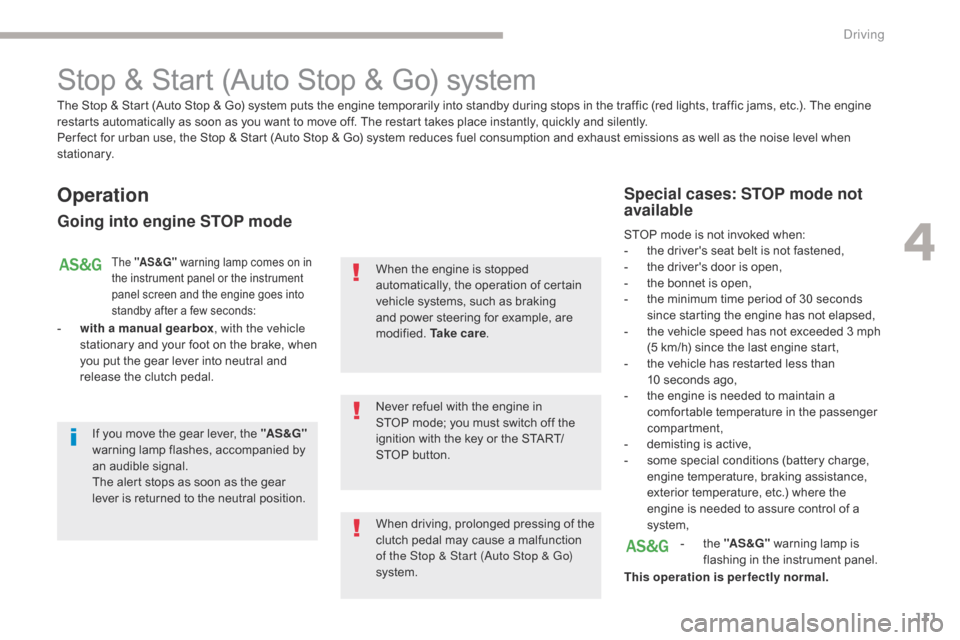
111
Stop & Start (Auto Stop & Go) system
Operation
Going into engine STOP mode
The "AS &G" warning lamp comes on in
the instrument panel or the instrument
panel screen and the engine goes into
standby after a few seconds:
- with a manual gearbox , with the vehicle
stationary and your foot on the brake, when
you put the gear lever into neutral and
release the clutch pedal.
Never refuel with the engine in
STOP
mode; you must switch off the
ignition with the key or the START/
STOP button. When the engine is stopped
automatically, the operation of certain
vehicle systems, such as braking
and power steering for example, are
modified. Ta k e c a r e .
Special cases: STOP mode not
available
STOP mode is not invoked when:
-
t he driver's seat belt is not fastened,
-
t
he driver's door is open,
-
t
he bonnet is open,
-
t
he minimum time period of 30 seconds
since starting the engine has not elapsed,
-
t
he vehicle speed has not exceeded 3 mph
(5 km/h) since the last engine start,
-
t
he vehicle has restarted less than
10
seconds ago,
-
t
he engine is needed to maintain a
comfortable temperature in the passenger
compartment,
-
d
emisting is active,
-
s
ome special conditions (battery charge,
engine temperature, braking assistance,
exterior temperature, etc.) where the
engine is needed to assure control of a
system,
-
t
he "AS &G" warning lamp is
flashing in the instrument panel.
This operation is perfectly normal.
The Stop & Start (Auto Stop & Go) system puts the engine temporarily into standby during stops in the traffic (red lights, traffic jams, etc.). The engine
restarts automatically as soon as you want to move off. The restart takes place instantly, quickly and silently.
Per fect for urban use, the Stop & Start (Auto Stop & Go) system reduces fuel consumption and exhaust emissions as well as the noise level when
stationary.
If you move the gear lever, the "AS &G"
warning lamp flashes, accompanied by
an audible signal.
The alert stops as soon as the gear
lever is returned to the neutral position.
When driving, prolonged pressing of the
clutch pedal may cause a malfunction
of the Stop & Start (Auto Stop & Go)
system.
4
Driving
Page 114 of 368
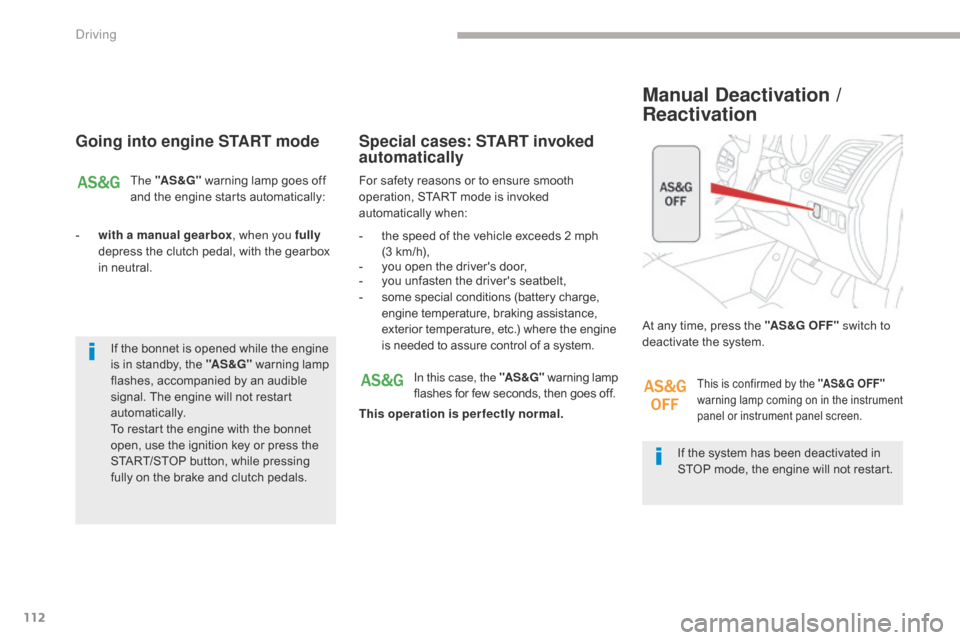
112
Going into engine START mode
The "AS &G" warning lamp goes off
and the engine starts automatically:
-
w
ith a manual gearbox , when you fully
depress the clutch pedal, with the gearbox
in neutral. For safety reasons or to ensure smooth
operation, START mode is invoked
automatically when:
Special cases: START invoked
automatically
- the speed of the vehicle exceeds 2 mph
(3 km/h),
-
y
ou open the driver's door,
-
y
ou unfasten the driver's seatbelt,
-
s
ome special conditions (battery charge,
engine temperature, braking assistance,
exterior temperature, etc.) where the engine
is needed to assure control of a system.
If the system has been deactivated in
STOP mode, the engine will not restart.
At any time, press the "AS &G O FF "
switch to
deactivate the system.
Manual Deactivation /
Reactivation
In this case, the "AS &G" warning lamp
flashes for few seconds, then goes off.
This operation is perfectly normal.This is confirmed by the "AS &G O FF "
warning lamp coming on in the instrument
panel or instrument panel screen.
If the bonnet is opened while the engine
is in standby, the "AS &G" warning lamp
flashes, accompanied by an audible
signal. The engine will not restart
automatically.
To restart the engine with the bonnet
open, use the ignition key or press the
START/STOP button, while pressing
fully on the brake and clutch pedals.
Driving
Page 115 of 368

113
The system is reactivated automatically
at every new start using the key or the
START/STOP button.
Opening the bonnet
Before carrying out any work under the
bonnet, deactivate Stop & Start to avoid
any risk of injury caused by automatic
triggering of START mode.
Press the "AS &G O FF "
switch again to
reactivate the function.
The system is active again; this is confirmed by
the "AS &G O FF " warning lamp going off in the
instrument panel or instrument panel screen.
Operating fault
In the event of a malfunction with the system,
the "AS &G O FF " warning lamp flashes in the
instrument panel or instrument panel screen,
and the system no longer operates.
Have it checked by a CITROËN dealer or a
qualified workshop. It is then necessary to switch off the ignition,
then restart the engine using the key or the
START/STOP button. In the event of a fault in STOP mode, the
vehicle may stall. The following warning lamps
come on in the instrument panel or instrument
panel screen:
4
Driving
Page 127 of 368
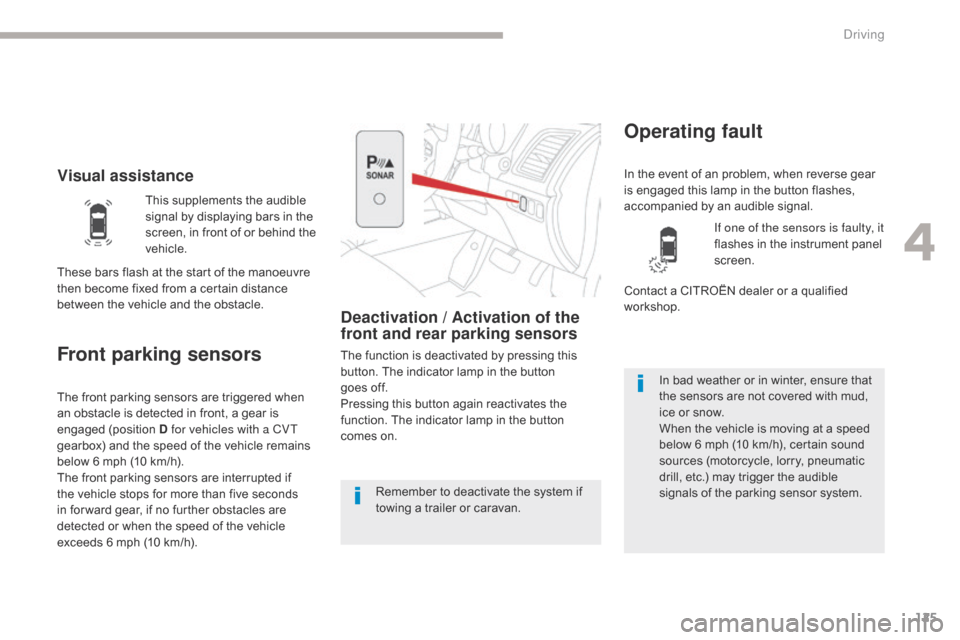
125
Visual assistance
Front parking sensors
Deactivation / Activation of the
front and rear parking sensors
The function is deactivated by pressing this
button. The indicator lamp in the button
goes off.
Pressing this button again reactivates the
function. The indicator lamp in the button
comes on.
Operating fault
The front parking sensors are triggered when
an obstacle is detected in front, a gear is
engaged (position D for vehicles with a CVT
gearbox) and the speed of the vehicle remains
below 6 mph (10 km/h).
The front parking sensors are interrupted if
the vehicle stops for more than five seconds
in for ward gear, if no further obstacles are
detected or when the speed of the vehicle
exceeds 6 mph (10 km/h). Remember to deactivate the system if
towing a trailer or caravan.In bad weather or in winter, ensure that
the sensors are not covered with mud,
ice or snow.
When the vehicle is moving at a speed
below 6 mph (10 km/h), certain sound
sources (motorcycle, lorry, pneumatic
drill, etc.) may trigger the audible
signals of the parking sensor system.
In the event of an problem, when reverse gear
is engaged this lamp in the button flashes,
accompanied by an audible signal.
This supplements the audible
signal by displaying bars in the
screen, in front of or behind the
vehicle. If one of the sensors is faulty, it
flashes in the instrument panel
screen.
Contact a CITROËN dealer or a qualified
workshop.
These bars flash at the start of the manoeuvre
then become fixed from a certain distance
between the vehicle and the obstacle.
4
Driving
Page 214 of 368

212
Check the electrolyte level and top up if
necessary.
For more information on Checking levels,
refer to the corresponding section.
Starting using another
battery
F Connect the red cable to the (+) terminal of the flat battery A , then to the (+) terminal of
the slave battery B . F
C onnect one end of the green or black
cable to the (-) terminal of the slave
battery
B.
F
C
onnect the other end of the green or black
cable to the earth point C on your vehicle
(engine mounting).
F
O
perate the starter, let the engine run.
F
W
ait until the engine returns to idle and
disconnect the cables.
F
R
aise the protective cover on
the (+) terminal.
Some functions, including Stop & Start,
are not available if the battery is not
sufficiently charged.
In the event of a breakdown
Page 216 of 368
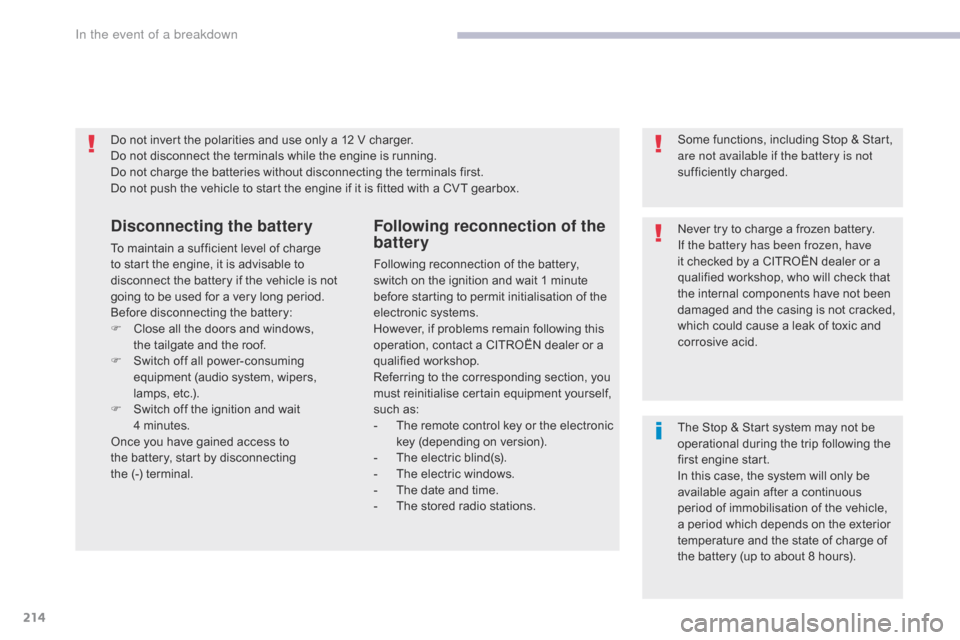
214
Do not invert the polarities and use only a 12 V charger.
Do not disconnect the terminals while the engine is running.
Do not charge the batteries without disconnecting the terminals first.
Do not push the vehicle to start the engine if it is fitted with a CVT gearbox.
Disconnecting the battery
To maintain a sufficient level of charge
to start the engine, it is advisable to
disconnect the battery if the vehicle is not
going to be used for a very long period.
Before disconnecting the battery:
F
C
lose all the doors and windows,
the
tailgate and the roof.
F
S
witch off all power-consuming
equipment (audio system, wipers,
lamps, etc.).
F
S
witch off the ignition and wait
4
m
inutes.
Once you have gained access to
the
battery, start by disconnecting
the (-) terminal.
Following reconnection of the
battery
Following reconnection of the battery,
switch on the ignition and wait 1 minute
before starting to permit initialisation of the
electronic systems.
However, if problems remain following this
operation, contact a CITROËN dealer or a
qualified workshop.
Referring to the corresponding section, you
must reinitialise certain equipment yourself,
such as:
-
T
he remote control key or the electronic
key (depending on version).
-
T
he electric blind(s).
-
T
he electric windows.
-
T
he date and time.
-
T
he stored radio stations. Some functions, including Stop & Start,
are not available if the battery is not
sufficiently charged.
Never try to charge a frozen battery.
If the battery has been frozen, have
it checked by a CITROËN dealer or a
qualified workshop, who will check that
the internal components have not been
damaged and the casing is not cracked,
which could cause a leak of toxic and
corrosive acid.
The Stop & Start system may not be
operational during the trip following the
first engine start.
In this case, the system will only be
available again after a continuous
period of immobilisation of the vehicle,
a period which depends on the exterior
temperature and the state of charge of
the battery (up to about 8 hours).
In the event of a breakdown
Page 221 of 368

219
* The maximum power corresponds to the value type-approved on a test bed, under conditions defined in European legislation (Directive 1999/99/EC).
Engines and gearboxes
.../S : model fitted with the Stop & Start (AS&G) function.
PETROL ENGINES
1.6 litre 1152.0 litre 150
GEARBOXES Manual
(5-speed) CVT
(6-speed) Manual
(5-speed) CVT
(6-speed)
Model codes: BU... NKZ0
NKZ0/S NKZ9
NKZ9/S AFYR
AFZ7 AFYV
AFZM AFYT
AFZH AFZ9 AFYW
AFZP
AFZC
Transmission mode 2WD2WD2WD 4WD2WD 4WD
Cubic capacity (cc) 1 5901 998
Bore x stroke (mm) 75 x 9086 x 86
Max power*: EU standard (kW) 86113
Max power engine speed (rpm) 6 0006 000
Max torque: EU standard (Nm) 15 419 9
Max torque engine speed (rpm) 4 0004 200
Fuel UnleadedUnleaded
Catalytic converter Ye sYe s
OIL CAPACITY (in litres)
Engine (with filter replacement) 4.24.3
9
Technical data
Page 227 of 368
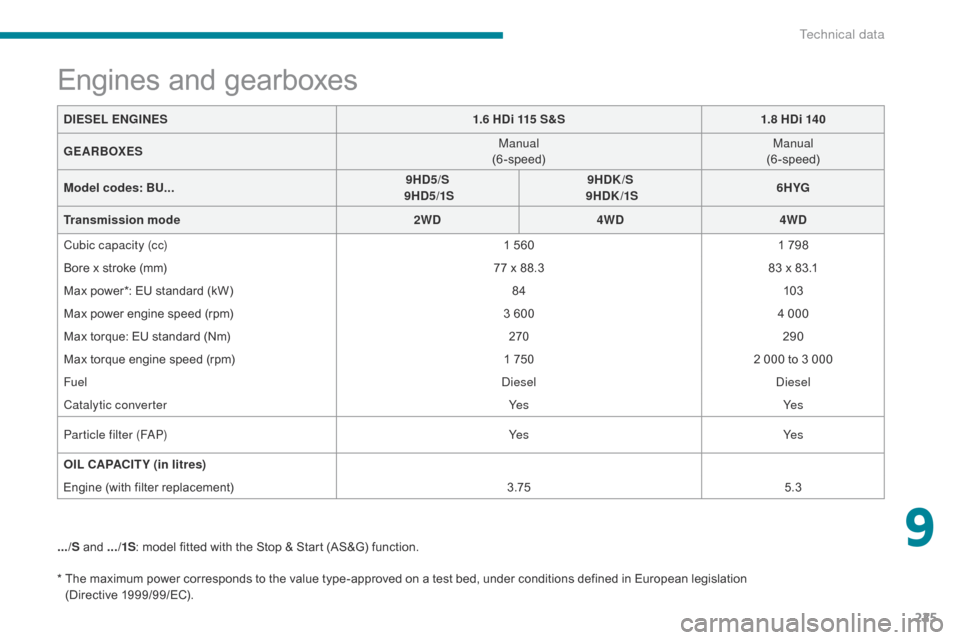
225
* The maximum power corresponds to the value type-approved on a test bed, under conditions defined in European legislation (Directive 1999/99/EC).
Engines and gearboxes
.../S and .../1S : model fitted with the Stop & Start (AS&G) function.
DIESEL ENGINES
1.6 HDi 115 S&S1.8 HDi 140
GEARBOXES Manual
(6-speed) Manual
(6-speed)
Model codes: BU... 9HD5/S
9HD5/1S 9HDK/S
9HDK /1S 6HYG
Transmission mode 2WD4WD4WD
Cubic capacity (cc) 1 5601 798
Bore x stroke (mm) 77 x 88.383 x 83.1
Max power*: EU standard (kW) 84103
Max power engine speed (rpm) 3 6004 000
Max torque: EU standard (Nm) 270290
Max torque engine speed (rpm) 1 7502 000 to 3 000
Fuel DieselDiesel
Catalytic converter Ye sYe s
Particle filter (FAP) Ye sYe s
OIL CAPACITY (in litres)
Engine (with filter replacement) 3.755.3
9
Technical data
Page 242 of 368

240Consult your mobile telephone's user manual and enter
the pairing code recorded in step 7 in the telephone.
BLUETOOTH® TELEPHONE
WITH
VOICE
RECOGNITION
The system says "Start the pairing procedure on the telephone.
Consult the instructions in the telephone manual ".
If the code is incorrect, the system locks. To clear the code:
-
check that the telephone's voice recognition is not activated,
-
with the ignition on and the audio system active, press the END
CALL
button for 2 seconds, 3 times in succession.
When it detects a Bluetooth
® compatible mobile telephone,
the
system says "Please say the name of the telephone after
the
beep".
After the audible signal, allocate a name to the telephone
by saying the name of your choice. The system says "Allocate an order of priority between 1 and 7.
One is the highest level of priority
".
Give a number between 1 and 7 to establish the level of
priority of the mobile telephone.
The system says and confirms the "name of the telephone " and
the "number" of its priority.
Answer "Ye s ".
Say "No" to return to step 13.
The systems says "Pairing complete" then emits an audible signal
and deactivates the voice recognition.
The services available depend on the network, the SIM card and the compatibility of the Bluetooth
® telephone used. Check in your telephone
user
manual and with your service provider for the services you have access to.
If the system does not detect the Bluetooth
® compatible mobile
telephone, the matching process stops ands is accompanied by an
audible signal.
If you select a level of priority which has already been allocated to
another telephone, the system asks you if you wish to replace this
level of priority.
Page 299 of 368
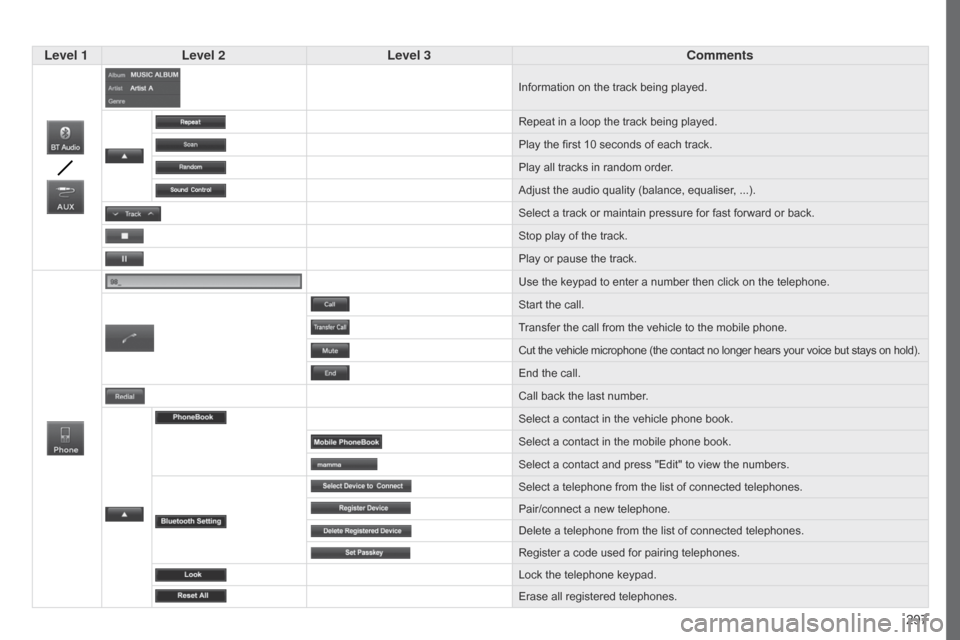
297
Level 1
Level 2 Level 3 Comments
Information on the track being played.
Repeat in a loop the track being played.
Play the first 10
seconds of each track.
Play all tracks in random order.
Adjust the audio quality (balance, equaliser,
...).
Select a track or maintain pressure for fast forward or back.
Stop play of the track.
Play or pause the track.
Use the keypad to enter a number then click on the telephone.
Start the call.
Transfer the call from the vehicle to the mobile phone.
Cut the vehicle microphone (the contact no longer hears your voice but stays on hold).
End the call.
Call back the last number.
Select a contact in the vehicle phone book.
Select a contact in the mobile phone book.
Select a contact and press "Edit" to view the numbers.
Select a telephone from the list of connected telephones.
Pair/connect a new telephone.
Delete a telephone from the list of connected telephones.
Register a code used for pairing telephones.
Lock the telephone keypad.
Erase all registered telephones.